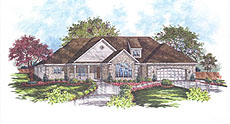Archives
House designed to permit "aging in place"
By PATRICIA DONOVAN
Contributing Editor
What would it be like to live in a lovely home that would accommodate young family life and be easily adapted to grow old with you?

A house that could, for instance, accommodate a temporary need to use a wheelchair or crutches; where bathrooms would be convenient and safe for use by a 3-year-old, a 90-year-old or a disabled resident or visitor. A home where counters and sinks could be raised and lowered easily for use by the very tall or the very small.
In short, a home that works with you and for you to accommodate your physical needs.
This year, you can visit just such a residence at the 2005 Horizon Home Show, sponsored by the Buffalo Niagara Builders Association, and being held Saturday through July 24. Located at 200 S. Rockingham Way, Amherst, it is one of eight homes constructed in the new Lake Forest suburban housing tract.
Home Show hours will be from 2-8 p.m. Tuesdays through Fridays and from noon to 6 p.m. Saturdays and Sundays.
The universally designed home, so called because it is designed to be accessible and convenient to use by everyone, including persons with disabilities, is the result of collaboration between architect Danise Levine, architectural research associate with the Center for Inclusive Design and Environmental Access (IDEA Center) in the UB School of Architecture and Planning, and Richard Bergman of Heartland Homes.
"This house, in particular," says Levine, "was designed to be adaptable to people with disabilities and to accommodate 'aging in place,' a term that refers to growing older without having to move to a different, more accommodating home."
Adaptable design, like that produced by architects in the IDEA Center, allows for easy modification of a residence to suit individual needs or preferences as they change over time.
"Our adaptable house, built according to the principles of universal design, has all the features of a conventional house and more," Levine says. "It looks just like a standard home, but is designed to conceal certain features until they are needed.
"When modifications are required, they will be readily achievable without the use of skilled labor and without changing the inherent structure of the home," she says.
"For example, in this home, a no-step entry; wider doors and hallways; barrier-free shower; maneuvering clearances; differing-height kitchen countertops, control and switch locations; and other access features are clearly visible and integrated into the overall design.
"Less obvious features," she says, "include blocking behind the walls in all bathrooms to provide reinforcement for future grab bars that can be installed without demolishing the existing walls, and knee space concealed at the kitchen sink, with base cabinet doors that fold and slide back when needed to accommodate a wheelchair or permit a resident to sit at the sink to perform various activities."
Levine and her colleagues point out that houses have been built with the same features and dimensions for hundreds of years with no consideration of the functional diversity of those who will live in them and without any way of accommodating the physical needs of the residents throughout their lifetime.
Levine and Bergman have created an adaptable house that recognizes diversity by including universal-design principles and providing affordable solutions for aging in place.
"This house will be the only one in the show with no-step access," Levine says, "so we are arranging group tours that will accommodate any person, regardless of their age or physical ability." For more information, contact Levine by email at drlevine@ap.buffalo.edu.
Additional information about the Horizons Home Show is available on the Buffalo Niagara Builders Association Web site at http://www.bnba.org/ .
